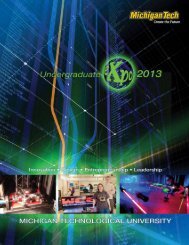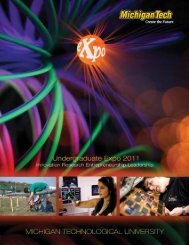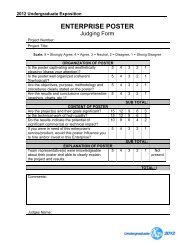Download - Undergraduate Expo - Michigan Technological University
Download - Undergraduate Expo - Michigan Technological University
Download - Undergraduate Expo - Michigan Technological University
You also want an ePaper? Increase the reach of your titles
YUMPU automatically turns print PDFs into web optimized ePapers that Google loves.
Senior Design<br />
146<br />
EZAC Creep Testing Team<br />
148<br />
Knee Brace Locking Mechanism<br />
149<br />
Electric DEF Tank Header Heater<br />
Three creep samples of EZAC, a zinc-based diecasting<br />
alloy developed by Eastern Alloys.<br />
Friction and mechanical advantage to make leg<br />
brace mechanism easier to use.<br />
3–D model of the prototype.<br />
Team Members<br />
Kyle Deane and Mike Knudsen, Materials Science<br />
and Engineering<br />
Advisor<br />
Dr. Paul Sanders<br />
Sponsor<br />
Eastern Alloys<br />
Project Overview<br />
This project studies the creep behavior of EZAC,<br />
a new zinc-based, die-casting alloy developed by<br />
Eastern Alloys. To accomplish this goal, work had<br />
to be done to fix the die-casting machine, die-cast<br />
samples, and creep test—in both EZAC and Zamak<br />
samples—for comparison. Six Sigma principles<br />
were employed to ensure the information gathered<br />
was statistically significant.<br />
Team Members<br />
Craig Pietila, Mikel Marshall, Bryan Rocheleau, Zhi<br />
Zhang, and Chris Pollock, Mechanical Engineering<br />
Advisor<br />
Dr. Gregory Odegard<br />
Sponsor<br />
Department of Mechanical Engineering-Engineering<br />
Mechanics<br />
Project Overview<br />
We are working to improve the locking mechanism<br />
on a knee brace used by children in India. The<br />
current lock is too difficult for the children to<br />
operate, so our task is to redesign the locking<br />
mechanism to make it easier to use.<br />
Team Members<br />
Lukas Lund, Alex Kaidan, and Chris Hughes,<br />
Mechanical Engineering; and Ron Kaunisto, Civil<br />
Engineering/Mechanical Engineering<br />
Advisor<br />
Dr. Gordon Parker<br />
Sponser<br />
John Deere<br />
Project Overview<br />
John Deere is required to meet US EPA-mandated<br />
(tier 4) emission standards, aimed at reducing<br />
environmental impact of diesel engines, all by<br />
2014. These standards specify the reduction of<br />
nitrous oxides (NOx) and particulate matter. John<br />
Deere is investigating the use of Selective Catalytic<br />
Reduction (SCR) systems to reduce NOx from the<br />
exhaust of diesel engines. This process uses a urea<br />
solution, called diesel exhaust fluid (DEF), which<br />
is injected into the exhaust and then converted<br />
into ammonia to chemically transform the NOx<br />
into nitrogen and water molecules. DEF freezes<br />
at -11C; therefore, vehicles operating below this<br />
temperature will require the DEF to be thawed. EPA<br />
regulations require injection to start within seventy<br />
minutes of startup at -18C. By this time, there must<br />
be adequate DEF available to maintain injection.<br />
The components needed for operation include a<br />
fluid heater, a temperature sensor, a level sensor,<br />
a suction line, and a return line within a five-gallon<br />
tank.<br />
Senior Design 2012 • 21






